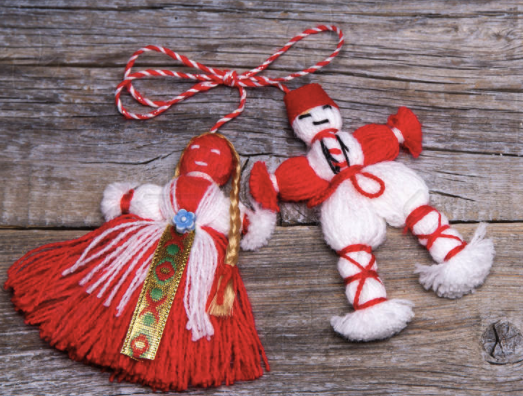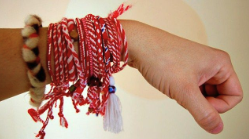Our Plovdiv office is our largest office at Reward Gateway and home to 300+ employees. In this article, our lovely Experience Manager, Ivelin Indzhov, or 'Uncle Ivo' for short, shares an old Bulgarian custom and his experience of how we keep our traditions and create a festive mood in our offices on March 1, aka Baba Marta’s Day - one of the most favorite holidays for children and adults across Bulgaria.
Legend or truth
There is no place in the world where people do not welcome Spring with great joy and excitement, but Bulgaria is one of the few countries where we celebrate its arrival with a holiday full of traditions whose roots are in the distant past of the Bulgarian people. Let me tell you the story of Baba Marta (Grandma Marta).
Once upon a time, there was a wonderful woman...Whether she was young and beautiful or old and lame, the legends are many and do not give us a clear idea. According to one of the legends, Baba Marta had two brothers, Malak Sechko and Golyam Sechko (the ancient names of January and February). One day they both made her very angry by making a big mischief - they drank their homemade wine without leaving a single sip for her to taste (here is the link with another Bulgarian tradition for the celebration of wine and the saint Trifon Zarezan). Another legend tells us about a young shepherdess who led her flock to graze in the mountains early one morning despite her husband's warnings of coming bad weather. She was convinced that Baba Marta would grant her excellent and sunny weather because she is a woman like her. The words of the young shepherdess angered the old woman, and soon storm clouds hung over the mountain. The shepherdess never returned to her home because she and her flock froze and then turned into a pile of stones from which healing water flowed.
Baba Marta
All the legends tell about the stormy and changeable mood of Baba Marta, which is reflected in the weather during the day. In the past, Bulgarians believed that when it was sunny and warm outside, Baba Marta was in a good mood, but when a strong wind blew and clouds covered the sun, she was in a bad mood. Legend has it that she went around peo ple's homes and their crops every day, wearing a red dress, red stockings, and a red headscarf. People believed that the old woman would only enter a tidy and clean house. This spring cleaning symbolized the release of everything old and unnecessary left over from the past year. The custom called for a red tablecloth or carpet to be brought out into the courtyard, and so people believed they would please Baba Marta and invoke her kindness towards the house and its inhabitants.
Red and white
The martenitsa is one of the most beloved Bulgarian symbols. It is made from twisted woolen or cotton white and red threads. Each of the colors has its meaning - white symbolizes purity, innocence, and a new beginning, and red symbolizes life, conception, and fertility. In some parts of Bulgaria, other colors such as green, blue, and yellow are added to the martenitsas. When making the martenitsa, the threads should always be twisted to the left, also sometimes other symbols may be added, such as a snail shell for health and strength, glass beads against lessons, a clove of garlic for protection from evil demons, or a small coin. for well-being.

Traditions and customs
At first, martenitsas were worn only by young women and children around their necks or attached to their dress, but later all people began to give and wear them. Nowadays, martenitsas are most often worn on the wrist in the form of a bracelet with wishes for health and longevity, luck, and success throughout the year.

Martenitsas are worn for a certain period, which is associated with recognizing the signs of the approaching Spring - the blossoming of trees or meeting the first storks coming from the south. In some parts of Bulgaria, young girls put their martenitsas under a large stone and thus guessed what their future husbands would be. Exactly after half a year, they returned to the same place, lifted the stone, and if there were ants stuck to the martenitsa, their chosen one would be rich and hardworking. In other parts, if people wanted to be saved from any evil, they should throw their martenitsas into running water to wash away the bad luck.
Interesting facts
- It is a common custom for everyone to choose a certain day up until March 22 (the beginning of the astronomical Spring) and, according to the weather on that day, find out what their year will be. If it is sunny, there will be a success, if the weather is bad - there will be difficulties.
- The martenitsa is an original Bulgarian "invention", but you can also see it in Romania and Greece. According to Romanian beliefs, the martenitsa (or "martisor" in Romanian) is an ancient pagan symbol of reviving nature at the beginning of Spring. This ancient custom is associated with the moment of the symbolic death and symbolic birth of a local female deity - Baba Dokia.
- On the occasion of Baba Marta on March 1, 2008, and 2011, through its Google Doodle application, the Google search engine logo was written in intertwined white and red threads and decorated with a red and white tassel.
Chestita Baba Marta
Regardless of its origin, the martenitsa remains one of the most iconic and beloved symbols of Bulgaria. White and red threads are what can connect all RG people in one day, no matter where they are on the globe.
Therefore, all of us from the BG office say 'CHESTITA BABA MARTA' and we wish you to be healthy and successful in your work until the end of the year. To learn more about our culture, traditions, and offices, visit rg.co/careers.
-png.png?width=594&height=378&name=EP!C_BabaMarta_3%20(2)-png.png)
 Ivelin Indzhov
Ivelin Indzhov
-1.png)